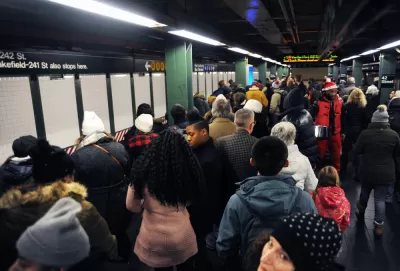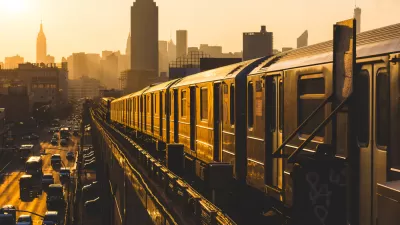With ridership still at less than half of pre-pandemic levels, the region's transit agencies face billions of dollars in budget shortfalls after federal assistance runs out.

Without the crush of pre-pandemic commuters, write Elise Young and Raeedah Wahid, New York City's public transit providers, who "rely heavily on fare revenue for day-to-day expenses," will have to make massive cuts in staff and service after federal pandemic relief dollars run out. With less than half of its typical ridership, New York's Metropolitan Transportation Authority faces a shortfall of billions of dollars.
"The non-profit Regional Plan Association, which researches New York City-area economic and environmental issues, predicts an eventual ridership recovery. But some commuters will trade the 9-to-5 workday for more flexible hours, driving up off-peak travel -- and potentially creating chaos, according to Tom Wright, the association’s president." Off-peak travel, says Wright, "actually puts more pressure on the transit agencies."
According to Redfin, "[r]eal estate in popular New York City suburban commuter hubs continued to soar during the pandemic, but the hotter single-family home market is in areas with little to no mass transit." Workers who are making their return to the city "are finding increased crime rates and vacancies among office towers’ street-level businesses that once teemed with commuters," evidence of the trickle-down effects of reduced workforces in central business districts, whose corporate offices created the need for a wide variety of ancillary services. If, as Richard Florida predicts, central business districts will transform into multi-purpose hubs and "15-minute neighborhoods" less dependent on daily commuters, transit agencies may once again need to readjust their service to cater to new needs and schedules.
FULL STORY: NYC Needs the Commuting Crowds That Have Yet to Fully Return

Trump Administration Could Effectively End Housing Voucher Program
Federal officials are eyeing major cuts to the Section 8 program that helps millions of low-income households pay rent.

Planetizen Federal Action Tracker
A weekly monitor of how Trump’s orders and actions are impacting planners and planning in America.

Ken Jennings Launches Transit Web Series
The Jeopardy champ wants you to ride public transit.

Washington Legislature Passes Rent Increase Cap
A bill that caps rent increases at 7 percent plus inflation is headed to the governor’s desk.

From Planning to Action: How LA County Is Rethinking Climate Resilience
Chief Sustainability Officer Rita Kampalath outlines the County’s shift from planning to implementation in its climate resilience efforts, emphasizing cross-departmental coordination, updated recovery strategies, and the need for flexible funding.

New Mexico Aging Department Commits to Helping Seniors Age ‘In Place’ and ‘Autonomously’ in New Draft Plan
As New Mexico’s population of seniors continues to grow, the state’s aging department is proposing expanded initiatives to help seniors maintain their autonomy while also supporting family caregivers.
Urban Design for Planners 1: Software Tools
This six-course series explores essential urban design concepts using open source software and equips planners with the tools they need to participate fully in the urban design process.
Planning for Universal Design
Learn the tools for implementing Universal Design in planning regulations.
Heyer Gruel & Associates PA
Ada County Highway District
Institute for Housing and Urban Development Studies (IHS)
City of Grandview
Harvard GSD Executive Education
Toledo-Lucas County Plan Commissions
Salt Lake City
NYU Wagner Graduate School of Public Service





























